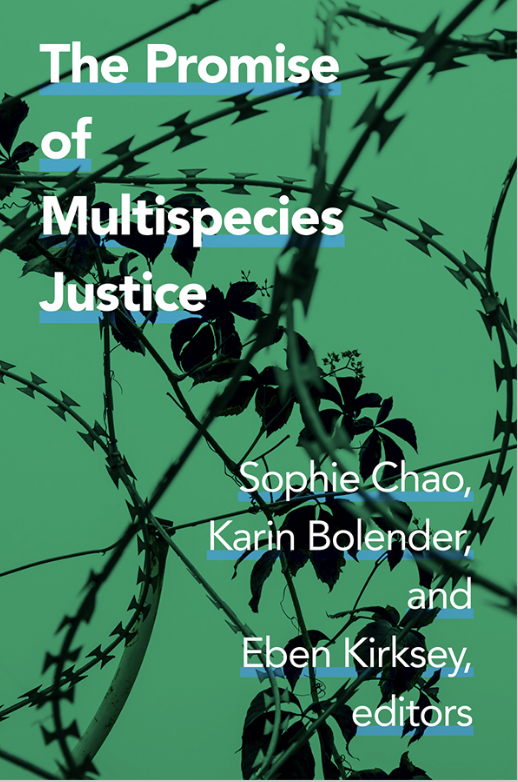SOPHIE CHAO, KARIN BOLENDER, EBEN KIRSKEY (eds.), 2022, The Promise of Multispecies Justice. Durham/ London: Duke University Press, 284 pp., ISBN: 978-1-4780-1889-6
This edited volume starts with the question who benefits from multispecies justice, and it remains a central question throughout the book. Drawing from Western philosophy and the political science of rights, the starting points of The Promise of Multispecies Justice is thinking critically about whose justice is at stake and who seeks justice. By bridging the human/more-than-human realms, the editors in the introduction demonstrate well how peoples and species create alliances, even though Western legacies of colonialism continue to separate species and create hierarchies between them.
The book contains an introduction, nine chapters, 2 poems, and an afterword, and the contributors are scholars from different fields and backgrounds, and artists. The narratives of the book allow the reader to hear the stories of individuals and collectives entangled with diverse forms of life. The authors’ investigations and interactions with their interlocutors have undoubtedly been long-standing, and the reader learns about the Hanford nuclear reservation; the Wanapun’s sacred sites; the toxicity of deep time; pesticides, bananas and people in the Philippines; trapmaker Iddy and rodents in Morogo, Tanzania; feral dogs and Amir in Baku; a deceased Gattu bull, his caretaker Pushkar, and Gattu’s spiritual journey; juridical and legal processes and the rights of Amazon forest; Indigenous leaders and Judge Tolosa in Columbia; the effects of conservation; the effects of humans’ learning about extinct bird, and many other topics. The chapters offer in-depth descriptions and analyses of multispecies becomings and interdependencies.
The book is ambitious and engaging. The authors offer a wealth of new information even for those who thought they knew the cases and places well. Clearly, the writers have worked on their contributions for some time jointly, and the volume is in fact the fruit of a series of talks, and in that way there are a good number of references to other chapters in the book, making it coherently related.
The introduction to the book is followed by a Glossary Species of Justice, which is very useful to analyze how inequalities and claims for justice can be experienced, constructed, and ordered. It includes those forms of justice that emerge as concepts from the chapters of the book, and which allow an understanding of justice from new ontological and temporal perspectives. The types of justice drawn from localized cases, include spectral justice (Chapter 1 by Govindrajan), transitional justice (Chapter 2 by Lyons), multiworld justice (Chapter 5 by Marder), and generative justice (Chapter 7 by Lee). Many of these kinds of justice, however, are not fully addressed in the book or are only mentioned in the Introduction. In the multispecies approach and relations, such ideas as intergenerational justice, patchy justice, and climate justice might have opened up new avenues for theorizing. In Indigenous contexts, for instance, climate justice involves not only vulnerable humans, but diverse more-than-humans and other-humans (animals, plants, ancestral spirits) that are part of social relations. Similarly, intergenerational justice among more-than-humans may open up noteworthy discussions about plants, which reproduce in different ways, from clones, from seeds, from being planted, and so on. The editors also mention that Indigenous societies still actively seek recognition for their interspecies relations from the perspective of species divide and their thinking on humans’ impacts on ecosystems and other species.
The depth of the description on the historical and political contexts that situate the stories is fascinating.However, sometimes the reader wonders where they are being taken by the story, and it is not obvious if the writing refers to Asia, Africa, the Caucasus, or to America. In fact, this is not a major problem, as many of the species live cross borders, continents, nation states, and at the core of this book are the possibilities of multispecies justice. The stories of loss, extinction, abolitions, destruction, longings, and claims for justice are read with sadness, but there is also hope of new kinds of co-becomings, memorizing, and finally justice of different kinds, especially justice that is restorative, transformative, and transitional.
The contributions are ethnographic essays and works of arts. The role of creativity and the arts played in this edited volume is highlighted and acknowledged. It unfolds naturally throughout the book, and becomes on integral part of the text-form contributions. The illustrations that open the different chapters succeed in revealing new aspects of the range of topics
The introduction mentions in an innovative way interspecies’ intersectionality, which seems a convincing way to understand how social and political action can play a role in creating different kinds of multispecies justice. Intersectionality might have been addressed more thoroughly in the chapters, as it is an important aspect of multispecies justice.
In sum, The Promise of Multispecies Justice provides novel and thought-provoking perspectives concerning the experience of injustice and justice. It is a compulsory read for scholars in many fields, from the diverse fields of human, social, and life sciences. It is relevant and valuable for anyone interested in how to transit towards a fairer society.
Pirjo Kristiina Virtanen
University of Helsinki
© 2023 Pirjo Kristiina Virtanen

